#roadside botany
Explore tagged Tumblr posts
Text


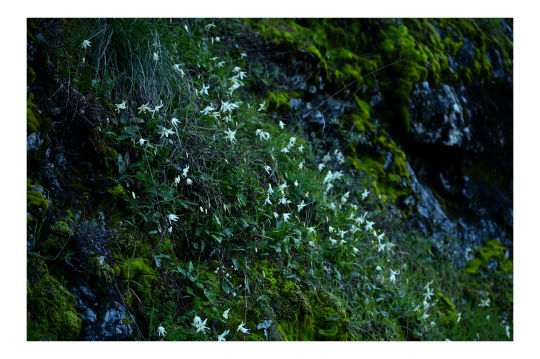
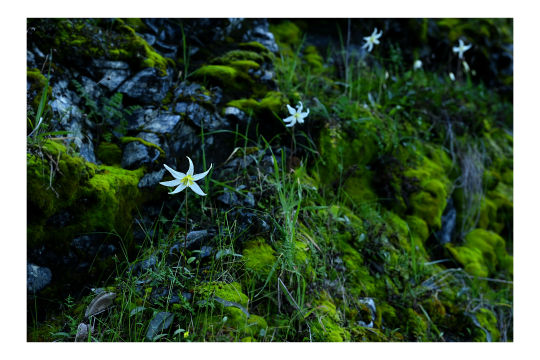
Fawn Lilies, Erythronium californicum, blooming on a roadcut!
#Erythronium californicum#fawn lily#spring#serpentine#maxxing#hell yeah#roadcut#botany#roadside botany#northern california#naturecore#flower photography#botany photography#nature photography#macrophotography#original photographers#nikon photography#nikon#24mm-120mm#photographers on tumblr
48 notes
·
View notes
Text







Roadside botany with the Bean
10 notes
·
View notes
Text
23–12–2024, Monday
video lecture of ecosystem
video lecture of biodiversity
dpp on human reproduction
quick revision of ecosystem from botany med easy (vipu bhaiya op)
quick revision of biodiversity also from the med easy
attended biology tuition
eng lecture of a roadside stand
quick revision of physics formulae of chp 1 and 2
video lecture of psychology
plan for tomorrow
7.30 - 9 read ecosystem
9 - 10 read eng chp
10 - 12 attend maths tuition
12 - 12.30 solve dpp of chem
1.30 - 2.30 solve physics paper
4 - 6 continue solving physics paper
6 - 7 revise physics derivations
7 - 9 attend physics tuition
9 - 10 read practical
11 - 12 psych video lecture
6 notes
·
View notes
Text
Birds Thrive Better in Urban Grass Fields Than Along Roads
Birds Thrive Better in Urban Grass Fields Than Along Roads https://ift.tt/HrqDzbl When it comes to making green space for wildlife in cities, quantity is as crucial as quality. Bichi and colleagues studied how different urban environments affect bird populations in Malaysia’s cities. The team looked at two types of areas: grassy fields and roadsides with trees. They found over 2,000 birds from 75 different species, but there was a striking difference between the habitats. The difference between habitats was clear: grass fields supported far more birds than roadsides, with 1,252 birds from 66 species in grassy areas compared to 849 birds from 52 species along roads. Birds that eat a varied diet were most common, while predatory birds were rarest. Weather played a big role too – both the number and types of birds changed between wet and dry seasons. This pattern held true across different seasons, suggesting grass fields consistently provide better bird habitat in urban areas. How do you count birds in a busy city? The research team had a plan. They set up 60 observation points spread evenly between grassy areas and roadsides. Each morning between 7-11am, when birds are most active, they spent exactly 10 minutes at each point counting every bird they could see or hear within 50 metres – about the length of an Olympic swimming pool. To capture seasonal changes, they visited each spot twice: once in the dry season (August-September) and once in the wet season (October-November). They stayed away during heavy rain or strong winds, as this would make spotting birds much harder. Cities are spreading worldwide. By 2050, an extra 2.5 billion people will be living in urban areas – that’s like adding over 300 Londons to our planet. This rapid growth puts pressure on wildlife, but cities don’t have to be concrete deserts. Birds are particularly good at adapting to urban life, and they do vital jobs in our cities: they eat pest insects, spread plant seeds, and pollinate flowers. Previous studies have shown that roads can be tough places for birds to live. Traffic noise makes it harder for them to hear each other’s songs and warnings, while moving vehicles pose obvious dangers. Studies like this one, from different cities around the world, help us understand which urban features help wildlife thrive – and which ones create problems. Bichi, H. M., Azhar, B., Yahya, M. S., Hadi, M. A., Ogunjinmi, A. A., Kamarudin, N., & Norhisham, A. R. (2024). Grass fields play a greater role in maintaining avian biodiversity in urban landscapes than roadsides. Urban Ecosystems, 28:0. https://doi.org/10.1007/s11252-024-01621-2 ($) Read free with ReadCube: https://rdcu.be/dYg77 Cross-posted to Bluesky, Mastodon & Threads. The post Birds Thrive Better in Urban Grass Fields Than Along Roads appeared first on Botany One. via Botany One https://botany.one/ October 28, 2024 at 12:30PM
3 notes
·
View notes
Text
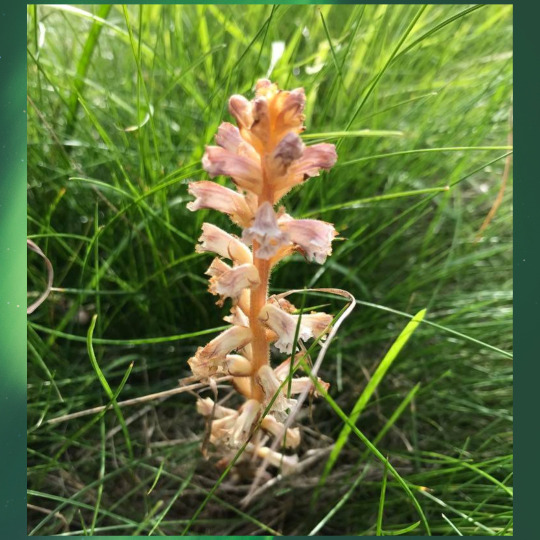
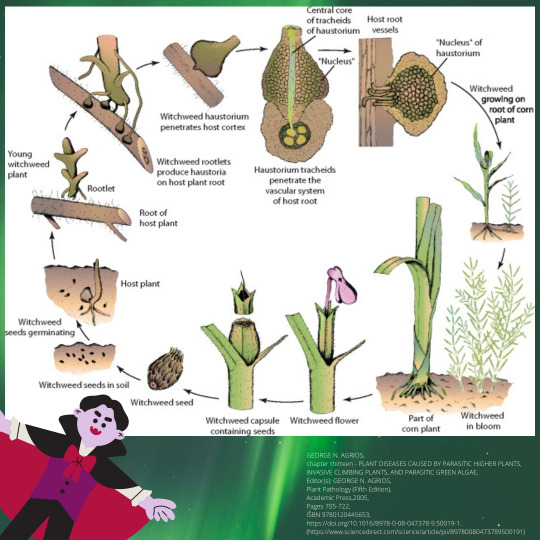
Imagine finding this unusual-looking wildflower in a summer meadow... One might assume, based on its mauve colour and upright growth, that it is a native European orchid. However, the truth is far stranger and more sinister - this odd wildflower is a "vegetable vampire" sucking the vitality from nearby plants!
The Common Broomrape (Orobranche minor) is a species of parasitic plant distributed across Europe. This plant is a "holoparasite", meaning it still has the basic anatomy of a plant (leaves, stems, roots, and flowers) but it lacks the ability to do photosynthesis and thereby generate its own energy for growth and reproduction. Most members of the Orobrancheae plant family are parasites, including the famous Striga genus which is a major pest of economically important crops such as maize and sugarcane in Sub Saharan Africa.
How does the "vampire" find its victims? Broomrape seeds can remain dormant in the soil of meadows, roadsides, and other environments for many years. If a preferred host plant starts growing near the dormant seeds, the seeds sense biological chemicals released by the potential host plants' roots. The Broomrape prefers Fabaceae (Pea family) and Asteraceae (Daisy family) plants. As the parasitic plant germinate and grows, it develops specialised roots called "haustoria" that physically penetrate the hosts' roots and extract nutrients from the host. The "vampire feeding" happens underground, so the Broomrape appears to be another innocent wildflower aboveground.
If you find a Broomrape anywhere in the UK or Europe, don't feel compelled to be a "vampire hunter" and destroy it. Please leave it be! The native European Broomrape is part of the natural ecosystem and it does not harm any crops or garden plants.
#broomrape#orobranche#striga#witchweed#parasitic#parasite#parasiticplant#orobanche#creepyplant#vampire#vampireplant#haustoria#parasitism#plantbiology#plantscience#botany#wildflower#katia_plantscientist
#katia plant scientist#botany#plant biology#plants#plant science#parasite#parasitic plants#parasites#parasitism#weird nature#wildflowers#thief#vampires#vampire#creepy nature#spooky nature#uk nature#plant photography#flowers
12 notes
·
View notes
Note
For the word game: flower?
From we will make this place our home, a lesson in botany:
“What’s this flower?” I would ask, pointing to a little plant with small white flowers and heart-shaped seedpods, and Linher told me it was called shepherd’s purse; or a taller plant growing on the roadside with long feathery leaves and heads of creamy-white flowers – that was yarrow, and Linher said there were old stories about it healing wounds made by iron; or a plant like a nettle with circlets of pink flowers – that was red dead-nettle, and quite harmless.
And from my other WIP, coirë:
“Look, Russo,” he exclaimed suddenly, leaning forward. “Even here there are flowers!”
New shoots surrounded the slender trees; bladelike leaves pushed bravely up to colour the bank green – and, yes, there were flowers: delicate petals of ice-white, suspended like hanging lanterns upon finely-wrought stems.
It was not a surprise to learn that his uncle’s people held them dear, the first promise of winter’s ending; but it was the flower’s tenacity that struck Russandol.
(there are more but these are the best ones i think)
Thanks for the ask :)
5 notes
·
View notes
Text
Eastern Suburbs Automotive: Your Trusted Vehicle Repair Partner in Botany
Is your car in need of a tune-up, service, or repair? Look no further than Eastern Suburbs Automotive, your go-to destination for top-notch vehicle repair in Botany. With a team of experienced mechanics and state-of-the-art equipment, we offer a wide range of automotive services to keep your vehicle running smoothly.
Why Choose Eastern Suburbs Automotive?
Expert Mechanics: Our technicians have years of experience working on various makes and models, ensuring that your vehicle receives the care it deserves.
Quality Service: We use only the highest quality parts and products to guarantee exceptional results.
Affordable Prices: Our competitive pricing means you can get your car back on the road without breaking the bank.
Convenient Location: We are conveniently located in Botany, making it easy for you to access our services.
Customer Satisfaction: Your satisfaction is our top priority. We strive to provide excellent customer service and ensure you are happy with our work.
Services We Offer
Logbook Servicing: Adhere to your vehicle's manufacturer's recommended service schedule to maintain its performance and longevity.
General Repairs: From minor tune-ups to major engine overhauls, we can handle all your repair needs.
Brake Services: Ensure your brakes are in top condition for safe driving with our comprehensive brake inspections and repairs.
Tyre Services: We offer tyre sales, fitting, and balancing to keep your vehicle running smoothly.
Air Conditioning Repairs: Keep cool and comfortable during hot weather with our air conditioning repair and maintenance services.
Electrical Repairs: Our technicians can diagnose and repair electrical issues in your vehicle.
Roadside Assistance: Get back on the road quickly with our reliable roadside assistance services.
Don't let car problems slow you down. Schedule an appointment with Eastern Suburbs Automotive today and experience the difference. Contact us.
0 notes
Text
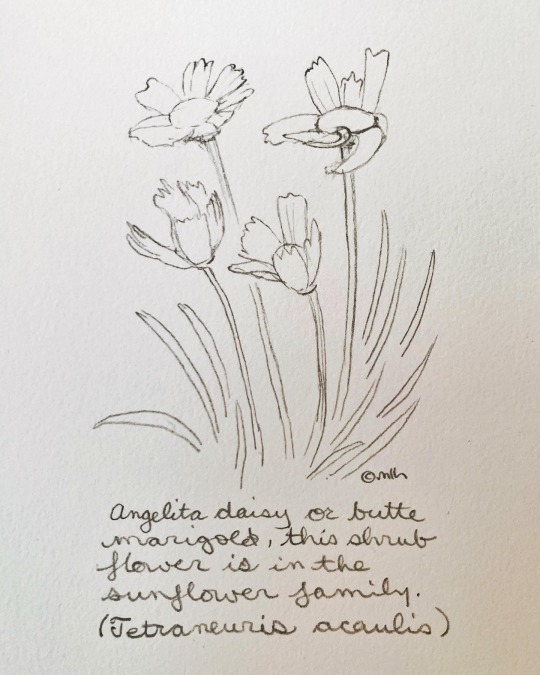

Angelita Daisy or Butte Marigold, this shrubby flower is in the sunflower family. (Tetraneuris acaulis). As seen near Chugwater, Wyoming, June 2022.
0 notes
Photo

Piece of digital botanic art entitled Chicory Seven
https://fineartamerica.com/featured/chicory-seven-frans-blok.html
#chicory#flower#wildflower#seven#7#wheel#rotation#star#blue#nature#botany#digital art#botanic art#kaleidoscope#roadside#summer
0 notes
Photo

Long grass. #green #nature #botany #roadside #foliage
1 note
·
View note
Text



Lilies, budding at 4,000' in the shade of Red Fir atop the South Fork Mountains. Think these will turn out to be Leopard Lilies, Lilium pardalinum, based off the location and elevation.
Edit: I've gone back to the spot, turns out they are washington lilies, Lilium washingtonianum purpurescens
Six Rivers National Forest, California
#lilium#lilium pardalinum#leopard lily#red fir#forest floor#summer#public lands#roadside botany#naturecore#beautiful nature#botanical photography#nature photography#flower photography#macrophotography#nikon#nikon photography#105mm#original photographers#photographers on tumblr
25 notes
·
View notes
Photo

Hi! As people who see this blog know, plant identification and seeking out native plants are close to my heart. I was very lucky—my parents showed me the plants and probably started teaching me their names even before I could talk. The spring ephemerals, early blooming woodland flowers that grow where the great forests once stood, were their favorites, so I know them best. As I started wanting to learn more, though, I got books, especially the Peterson Guide to Wildflowers of Northeastern North America, I think that’s the title. Instead of organizing flowers botanically according to their leaf structure and flower parts, it organizes them by color, and when I started out that seemed easier to me. Later I also got Newcomb’s guide to the Northeast which is arranged more according to the botany. It really helps to have someone you can ask. Some plants are easy, but then even easy ones can be tricky once in a while. I had the advantage of often knowing plant and flower forms well enough that I could make a decent guess what family a new plant belonged to, but most people don’t start out like that. And the internet doesn’t help as much as you would think because I frequently find plants being identified differently by different people even on sites that seem reputable and knowledgeable. I would say get a guide, whatever kind you think you would like or both kinds, and start by identifying blooming plants right around you. (Not garden flowers! They won’t be in the books for the most part and they’re a whole other can of worms.) Try identifying plants in cracks in the sidewalk, weeds that come up in your garden, plants in empty lots or along roadsides if you’re rural. A lot of them aren’t native but they will probably be in the books. Doing that will help you start to notice things like leaf shape and texture, subtle color differences in the green parts of a plant, and how individual flowers look close up. Just make sure you learn what nettles and poison ivy look like first so you don’t get stung or end up with an itchy rash for a week or two! There’s a lot more I could say but I’ll stop there for now. Be sure to read the comments, because I’m guessing people will jump in with their favorite plant apps. I don’t think there’s a good one that identifies plants in the U.S. just by taking a picture. There may be one for the U.K. though. Feel free to ask me any further questions. I think identifying plants is more important than people think, and I find it fun and at times exciting. You sometimes find cool and unusual things. Plus, being able to do it makes you a desirable person to around have in the event of an apocalypse or societal breakdown. ;-) A number of wild plants are delicious and nutritious, but some really really aren’t safe. It’s good to know which are which. Don’t harvest native plants unless the place where you’re getting them has an almost unlimited supply. Take as much garlic mustard as you want, though! Good luck. 💚
1K notes
·
View notes
Photo

BEAUTIFUL PEOPLE! This is a gentle & sweet reminder to let ya know our EARLY BIRD offering for our Mushrooms & Culture of Greece trip this fall ends in ONE MONTH! After August 13th our 11 day fungal and botanical meandering through Greece goes up in price, so PLEASE get in touch if you’re thinking you’ll be joining us this year! This is a once in a lifetime chance to be in these places, and to learn from the folks we are bringing and collaborating with. More on that soon! Come see the blankets of blooming Cyclamen emerging from precious limestone soils on the warm Fall days with us! They’re stunning! The cute roadside, goat herd pic was taken by loved one @mindfulmedicinals who joined us back in 2018 and ascended with us in the gorgeous southern Pindus mountains of Tzoumerka where we will be returning to again this year! That was so fun! So grateful for everyone who has ever joined us and been through these lands with us, then and now! You have helped craft this space and time with me and it means so much. Thank you! Every year and every time we return we have new and incredible experiences that imprint for a lifetime. The smells, the tastes, the sounds! Yummmmmmmy! Join us and help us spread the word! This trip isn’t for someone wanting wait staff poolside with endless drinks, this is for someone who wants to learn, experience and immerse in the biology and ecology of a region and taste their way through. Medicine is made, food is cooked and fires are stoked! Join us! www.SmugtownMushrooms.com/greeceoctober2022 #smugtownmushrooms #fungi #mushrooms #wildmushrooms #mycelium #greece #ellada #mushroommedicine #mycology #mushroomsandcultureofgreece #love #foraging #botany #plantmedicine #traditionalknowledge #pindusmountains #lefkada #funga #love (at Tzoumerka, Greece) https://www.instagram.com/p/Cf_04WtOL3-/?igshid=NGJjMDIxMWI=
#smugtownmushrooms#fungi#mushrooms#wildmushrooms#mycelium#greece#ellada#mushroommedicine#mycology#mushroomsandcultureofgreece#love#foraging#botany#plantmedicine#traditionalknowledge#pindusmountains#lefkada#funga
2 notes
·
View notes
Text
How Venus Flytraps Disappear into the Underworld
How Venus Flytraps Disappear into the Underworld https://ift.tt/0eFmQtN Venus flytraps, native to the Carolinas, are threatened by illegal collecting for the horticultural trade. Margulies and colleagues studied this issue, revealing a complex network of collectors, nurseries, and buyers. While habitat loss is the primary threat, illegal harvesting significantly impacts smaller populations. Various actors, from local opportunists to specialist collectors, drive this illicit market. Understanding this trade is crucial for protecting Venus flytraps and similar at-risk plant species. The study identified three main types of Venus flytrap collectors: subsistence harvesters, opportunistic collectors, and specialist collectors. The illegal trade chain typically moves from collectors to nurseries to buyers. Experts noted that large-scale collectors may receive only $0.25-1.00 per plant, far less than retail prices. Collecting hotspots include areas near trails and roadsides. However, while illegal collecting remains a threat, habitat destruction and fire suppression pose greater risks to Venus flytrap populations. To understand Venus flytrap poaching, researchers gathered plant experts for a workshop. They asked questions, held discussions, and used activities to map out how the illegal trade works. Participants included scientists, conservation workers, and government staff. They shared their knowledge about flytrap collecting and ranked different threats to the plants. The researchers then carefully studied the workshop conversations to find important patterns and issues in the illegal trade. Venus flytraps are well-known carnivorous plants, but their illegal trade is not well understood. This study helps fill that knowledge gap. Despite laws and readily available cultivated plants, people still collect wild flytraps illegally. Although this research was focused on a single species from a monotypic genus, these findings for one of the most globally recognizable and sought-after carnivorous plants provide important insights that can inform interventions related to similarly high-demand wildlife species, including other carnivorous plants, that are traded internationally. Margulies, J. D., Trost, B., Hamon, L., Kerr, N. Z., Kunz, M., Randall, J. L., Shew, R. D., Shew, D. M., Starke, L., Suiter, D., & West, Z. (2024). Expert assessment of illegal collecting impacts on Venus flytraps and priorities for research on illegal trade. Conservation Biology, 38, e14320. https://doi.org/10.1111/cobi.14320 (OA) Cross-posted to Bluesky, Mastodon & Threads. The post How Venus Flytraps Disappear into the Underworld appeared first on Botany One. via Botany One https://botany.one/ September 18, 2024 at 08:30PM
0 notes
Text
Collected on this Day in 1957
Spring at Powdermill.
An early bloomer.

This specimen of coltsfoot (Tussilago farfara) was collected at Powdermill Nature Reserve, the field station of Carnegie Museum of Natural History in 1957, just one year after the facility was established. It was collected by Leroy Henry, a Curator of Botany at the museum from 1937 until 1972 (though he was also affiliated with museum before and after this period). Henry is an important collector for our region, with >36,000 specimens in the Carnegie Museum herbarium.

At first look, the plant may be confused with your common dandelion. It has definite similarities, as it is in the same plant family, Asteraceae, and bears yellow flowers. But, as you’ll notice from the specimen – flowering coltsfoot doesn’t have leaves!
Coltsfoot, which is native to Europe, was introduced to Pennsylvania, and is quite unique in our state’s flora. The plant blooms very early in the spring, with dandelion-like flowers frequently poking through the soil of otherwise barren slopes. The leaves soon follow, and they are shaped like – well – a colt’s foot! Quite different than the familiar serrated edge shape of dandelion leaves.
Coltsfoot’s early appearance also makes it a great species to track changes in bloom time using herbarium specimens. The species was among the first to be used in a pioneering study published in 2006 using herbarium specimens by Claud Lavoie and Daniel Lachance. In Southern Quebec, they found coltsfoot bloomed 15-31 days earlier in recent decades, compared to pre-1950. Earlier blooming was strongly linked to climate change in the region. The plants also showed a clear signal of flowering earlier in the city (due to a phenomenon known as urban heat island effect).

We have plenty of spring ephemerals that bloom early, but unlike these plants, coltsfoot doesn’t die off by summer. The plant keeps its leaves well after it blooms, into late fall.
This strategy is interesting, and I can’t think of many plants in our flora with similar growth patterns. Is the plant on to something?
Keep an eye out for coltsfoot, especially along wooded roadsides. Once you see a big bloom, check the same site later in the year. The leaves can grow to a surprisingly large size.
Find this specimen and more here.
Check back for more! Botanists at the Carnegie Museum of Natural History share digital specimens from the herbarium on dates they were collected. They are in the midst of a three-year project to digitize nearly 190,000 plant specimens collected in the region, making images and other data publicly available online. This effort is part of the Mid-Atlantic Megalopolis Project (mamdigitization.org), a network of thirteen herbaria spanning the densely populated urban corridor from Washington, D.C. to New York City to achieve a greater understanding of our urban areas, including the unique industrial and environmental history of the greater Pittsburgh region. This project is made possible by the National Science Foundation under grant no. 1801022.
Mason Heberling is Assistant Curator of Botany at Carnegie Museum of Natural History. Museum employees are encouraged to blog about their unique experiences and knowledge gained from working at the museum.
39 notes
·
View notes
